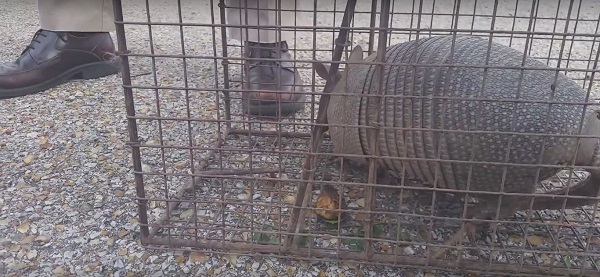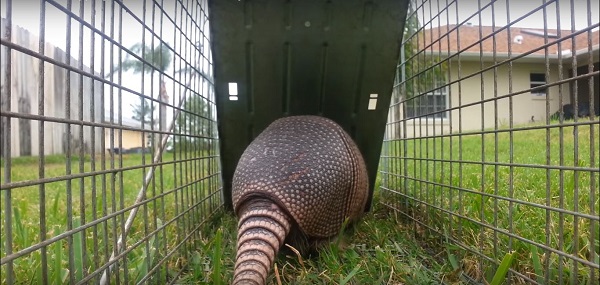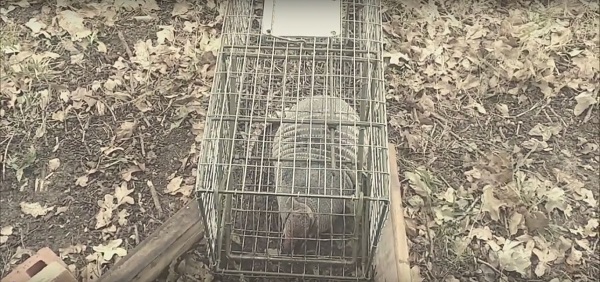
First off, I want to clear up a popular question: what kind of bait or food catches armadillos? The answer is: none. Armadillos dig for all of their food, and they only eat live worms and grubs that they dig
up. They won't eat any surface food. So there is no bait that works. It's all about how you POSITION the trap. Do that right, and it's not hard.
You have to position the trap where the armadillo was going to walk naturally, and it'll just go right in. Set the trap on the animal's walkway that it normally takes, or right on top of one of its many escape burrows.
You need the right kind of trap - a sturdy steel cage trap, and one large enough to trap a raccoon. Read more about
Is It Legal For Me To Trap An Armadillo and
What Equipment Is Needed To Trap An Armadillo?
Armadillo Trapping - How To Catch Armadillos with Traps
Armadillos are mammals, which are natives of North America. They have a characteristic
armory leather shell and are expert at digging up the ground in search of food. The word Armadillo is coined from the Spanish language meaning little
armored one. The giant armadillo may grow to a length of up to 59 inches and can weigh up to 59 kilograms or 130 pounds.
They can live in versatile environments, in North America including residential areas. They have strong claws, which they use to dig for food or burrows in the ground. They cause a lot of damage in a well manicured garden, if they invade it. Luckily they don't transmit rabies, which is a dangerous disease to pets and humans. There are several ways to get rid of these nocturnal animals, but the best method is to trap them alive and relocate them.
Preliminary steps to trapping an armadillo
You can trap the pesky animal by observing its activities like the time it comes into the garden or when it comes out of its hole or burrow. You should also take, not of the route it takes all the time. This information will help you to trap the animal efficiently. Armadillos are nocturnal animals, which mean that they are active during the night and dawn. You should also consult local authorities, so that you know if it is legal to catch an armadillo in your area, and euthanize it or relocate it. When it comes to choosing the right trap, you should take one, which is stable and strong, because armadillos can bend metal rods.
 Trapping an armadillo
Trapping an armadillo
You should put the trap at the point of entry of the armadillo's burrow or the path it takes every day. You can consider placing some barriers along the route to the trap, to lead the armadillo straight to the trap. Select a trap, which is meant for large animals. The barriers should be connected to the walls of the trap so that the animal does not take another route. You can use insects and worms in the trap as bait because armadillos love eating them. You can place some dirt in the trap to attract the animal, and to camouflage the trap.
You can efficiently trap an armadillo; you need to place several traps in the yard. At least, an armadillo will walk into one of the traps. After trapping an armadillo, you should contact an authorized wildlife control personnel to euthanize or relocate it if it is legal in your
state. He can relocate it to a place with lots of water and food so that it does not find its way back to your yard. Read more about
Where Should I Relocate A Trapped Armadillo? The animals love hiding, so the best place to relocate it should be with some brush and bushes. You should handle the animal cautiously because they host some diseases like rabies, salmonella and a bacterium known to cause leprosy. You can use protective clothes and gloves to remove it from the yard.
Bait
Do not use any bait. Armadillos only eat live food they dig out of the ground - mostly earthworms. Bait will only attract non-target animals like skunks, raccoons, opossums, or stray cats. Read more about
What Is The Best Bait To Trap An Armadillo?
Go back to the
How Do You Get Rid of Armadillos home page. You can also read my articles on:
how to kill an armadillo,
armadillo under the shed,
armadillo poison,
can armadillos transmit leprosy,
What Are Some Problems Caused By Armadillos Digging.
What to do after I catch it in a cage? The trapping of armadillos can benefit your local area by protecting certain animals and protecting people from Hansen's disease. However, various states and municipalities in the United States differ when it comes to the trapping and relocation of various animals including armadillos. It is necessary to know what to do with an armadillo in order to stay out of legal trouble and minimize the amount of effort and resources expended to protect your property. Therefore, it means that whatever happens with an armadillo upon its trapping will vary depending on the area that it was trapped in and what the owner wishes to do with it.

The more humane thing to do upon capturing an armadillo is not to neglect it and leave it to die. The neglect and death of the armadillo will be even worse for you since the smell of the dead armadillo will attract other pests. Since armadillos have the capacity to carry diseases and can resist you, it is vital to be careful handling the armadillo. In some states, you are allowed to relocate the armadillo at least six miles from your property to an area with enough food and water for the armadillo to survive and thrive. This will ensure that the armadillo will not return to your property.
In other states, you must euthanize the armadillo. If you are not sure, it is best to get in contact with someone who has better knowledge on the laws in your area regarding the relocation of armadillos. In most cases, people prefer relocating the armadillo since it is easier to do. If you do not want the armadillo or armadillos to return to your yard, it is important to repair the damage done to your yard. You must also remove any armadillo pups from your property if you find any. Treat the armadillo pups in the same way that you would treat the adult armadillos.
Many products that are advertised to be effective in keeping armadillos away from your yard are fraudulent products. An actual armadillo repellent does not exist anywhere in the world. There are even instances where these so-called armadillo repellents are bad for the environment. These animals are determined to survive and these repellents will do nothing to deter them from trying to live. Some of these fradulent solutions to invasive armadillos include mothballs, the urine of various predators, castor oil, and machines that generate high-pitched noises. Do not waste any of your time and money using these inefficient solutions.
To summarize, there are proper ways to get rid of armadillos that we capture in our yards. The ideal way to relocate an armadillo is to place at least six miles away from your home in a place with enough water and food for the armadillo to survive. If your local laws do not permit this, you will more than likely have to euthanize the animal and dispose of it as quickly as possible. When it comes to this issue, it is best to call an expert. With this information, the damage done to your yard by armadillos can be fixed.
Is it legal for me to trap an armadillo? Common complaints by those who deal with armadillos are that these creatures tend to dig tunnels and holes throughout their respective properties. Armadillos dig these holes either in an attempt to look for food or to build homes. They can also dig holes to birth their babies or pups. These animals are usually more active at night, therefore it is not always easy to spot them. However, the animal will leave evidence of its presence. As a result, trapping armadillos can preserve the integrity of your property.

There are certain ways to trap pesky armadillos. It is worth noting that there is no bait effective enough for the use of trapping armadillos. There have been numerous trapping experiments conducted, but all of these experiments have been unsuccessful. First off, a cage trap large enough for a raccoon should be used for the capture of the armadillo. The trap must also be able to withstand resistance from the armadillo. It is necessary to figure out the habits of the armadillo and tailor your approach to its habits. Making your trap look attractive for an armadillo is also important for trapping it.
The trapping of the armadillo itself is of questionable legality and depends on where you live. In Florida and Texas, it is legal to trap armadillos. Since armadillos are not entirely native to those states, it is not legal to relocate them. Despite this, there are people who transport and relocate armadillos anyway. In some states, the armadillo must be euthanized when captured. Other states criminalize trapping of armadillos by non-professionals. It is smart to check your local laws before taking any action to trap an armadillo in order to avoid running into legal trouble.
The damage done by armadillos is not substantial from an economic view and is mostly cosmetic damage. In rare circumstances, armadillos have been observed to cause structural damage to buildings. Flooding and other issues can be caused by the habits of armadillos as well. However, there are benefits to trapping armadillos. In Florida, armadillos are known to eat the eggs of certain animals. Armadillos have been known to carry leprosy or Hansen's disease too. Again, the chance of contracting Hansen's disease from an armadillo is rare. Compared to other pests and creatures, armadillos in general are not very dangerous or destructive.
Armadillos can be considered pests due to their lifestyles. Trapping armadillos can be a risky undertaking if not carried out properly. Therefore, it must be done in a professional way. The various states of America have different laws regarding the capture of armadillos and what is to happen after the capture of the armadillo. On average, armadillos are not dangerous and do not pose a massive economic threat when compared to other forms of wildlife. On the other side of this, there still are benefits to trapping them such as protecting the biodiversity of your state and protecting the public health of the other inhabitants of your state.
What equipment is needed to trap armadillos? Armadillos can be quite pesky. Trapping them is important if you want keep your yard in order. Fencing them off of your property may not always be an option for you. You should not let this deter you and there is still hope if you want to keep armadillos off of your lawn. I am going to tell you what equipment you need to trap armadillos that are on your lawn and how to properly use said equipment. Many of these materials are not too expensive and they do not require too much labor to construct. This will benefit you greatly in the long run.

First of all, you need to focus on getting a trap that is big enough for the armadillo and sturdy enough to withstand resistance from an armadillo’s claws and other bodily appendages since the armadillos are able to break through flimsy traps. Normally, a trap that closes from behind (the standard one-way trap) will work well enough to trap an armadillo. I should tell you that are not really any lethal traps that will be effective on armadillos since armadillos have the armor that they have. This armor provides them with enough protection from various things including some forms of lethal traps.
Using bait is pretty much optional in this scenario. Finding the right bait for an armadillo is not always easy and it does not always work. There are people who use fruit as bait. The problem with this is that it can attract other unwanted animals. This is the same with meats. Earthworms may work since armadillos enjoy eating earthworms. The people who did decide to use earthworms as bait put the earthworms in a stocking or in an old sock. If you cannot afford to use bait or do not have the time to figure this part of the process out, it is best to avoid this part.
When finding a strategic location to place the trap, it is best to track the armadillos and find out their habits and their ways. As a result, it will be much easier to trap them. Many armadillos usually have routes that they prefer to take when on your property. It is best to take a good look at your yard and determine where the armadillo spends the most time. From there, laying a trap down should be somewhat easy. It is very important to be smart and be vigilant when it comes to trapping the armadillo.
To trap an armadillo, you really only need one thing. You need a trap that is large enough for a cat or a raccoon and is strong enough to withstand escape attempts from the captured armadillo. A trap like this can be found at a hardware store or any other store that deals in those sorts of supplies. The use of bait when capturing an armadillo is optional and it is probably better not to expend any time or effort doing that. The last thing that is needed a strategic location to place the trap in order for it to do its job. Once these things are taken care of, you will be closer to keeping your yard secure.
Go back to the
How Do You Get Rid of Armadillos home page to read more about Is it legal for me to trap an armadillo?